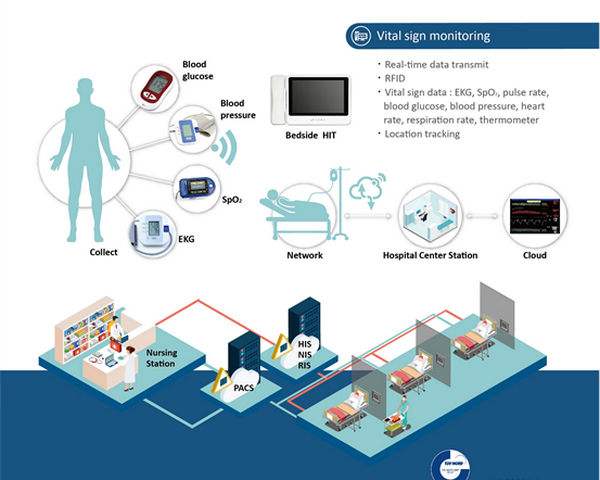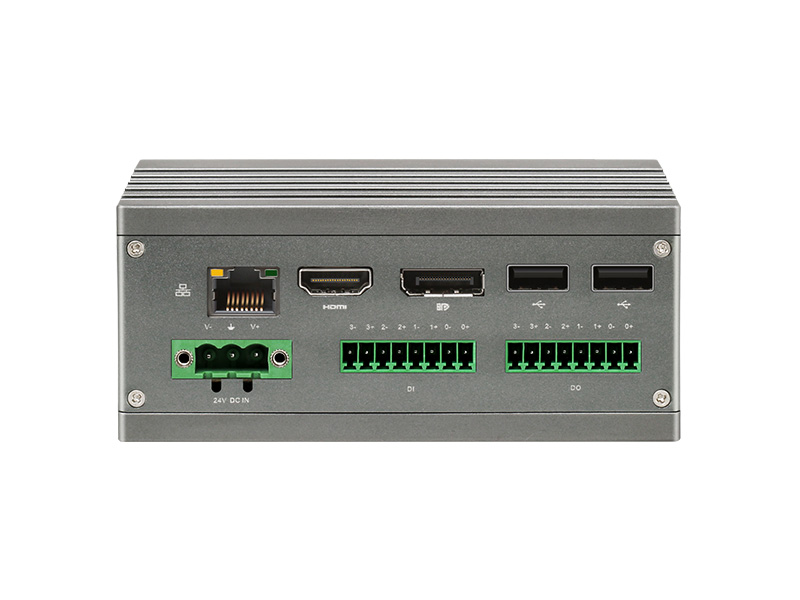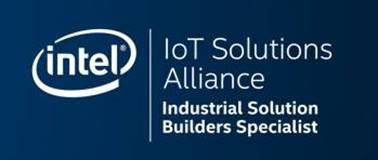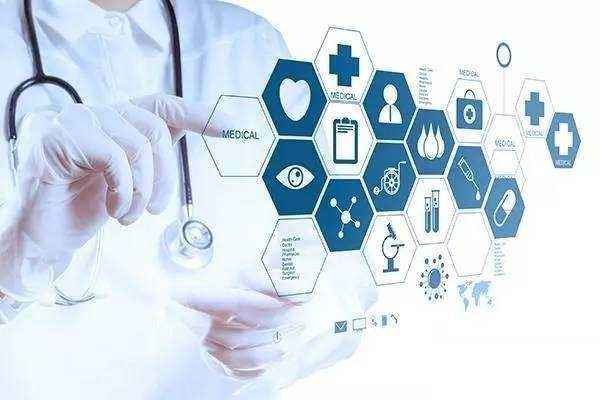Edge Computing supports IoT - Medical application
Paper in PDF
The Internet of Things (IoT) refers to a network of physical objects connected through the Internet. These physical objects include technologies that interact with internal factors and the external environment. IoT is being widely involved in retail, transportation, agriculture, smart home, smart city, lifestyle, supply chain, emergency, medical, environmental and energy fields. In the short term, the application of the Internet of Things in the medical field has increased significantly and is expected to continue to develop in the next few years.
The various benefits provided by the Internet of Things in the medical field are mainly divided into tracking devices, workers, and patients; identification and authentication of personnel; automatic data collection; and perception. By providing these benefits, the Internet of Things in the medical field has proven to be an important solution for managing various medical costs. In addition to providing better disease management, the Internet of Things in the medical field also enables stakeholders (especially providers and patients) to enhance patient care and effectiveness, reduce costs, reduce errors, and improve patient experience. IoT solutions and services are replacing traditional diagnostic and treatment procedures with advanced technology. IoT users in the medical field include hospitals, medical professionals, clinics, and patients. Government authorities, research institutes and diagnostic laboratories also use the Internet of Things in medical technology to develop cost-effective advanced products and solutions.

The following are the four factors that have led to an increase in the adoption rate of the Internet of Things in the medical industry.
a) Increased adoption of smart devices and wearable devices
b) The need to optimize the productivity of medical personnel
c) Increasing interest in self-health measurement
d) Demand for medical care in remote areas
Challenge
Although IoT solutions in the medical industry provide various benefits, unfortunately, there are still challenges to be solved. New medical data collected through Internet of Things devices, such as EHR data, digital pathology data, sensor data, diagnostic data of digital imaging equipment, and the increase in research data from the genome, resulting in excessive data that needs to be stored and processed. Such a large amount of data poses serious challenges to the medical industry. In addition, security issues related to violations of patient sensitive data are also emerging, and these data are used by criminals to obtain false insurance claims. To reduce the risks associated with data storage, organizations need to develop advanced security policies that enhance data privacy.
Research shows that nearly 60% of medical institutions worldwide are already using the Internet of Things to provide better care for patients. With solutions such as patient monitoring, smart pills and low-power positioning, the Internet of Things can help improve the quality of life of more people, thereby reducing medical expenses. Despite some challenges, the adoption rate is still increasing significantly due to the various benefits provided.
The edge computing model migrates some or all of the computing tasks of the original cloud computing center to the vicinity of the data source. Compared with the traditional cloud computing model, the edge computing model has real-time data processing and analysis, high security, privacy protection, and scalability. Strong, location-aware and low-traffic advantages.
ü Real-time data processing and analysis. Part or all of the original cloud computing center's computing tasks are migrated to the edge of the network, and the data is processed at the edge device instead of in the external data center or cloud; therefore, the data transmission performance is improved, the real-time performance of the processing is guaranteed, and it is also reduced Computing load of the cloud computing center.
ü High security. The traditional cloud computing model is centralized, which makes it vulnerable to distributed denial of service provision and power outages. The edge computing model distributes processing, storage, and applications between edge devices and cloud computing centers, making it highly secure. The edge computing model also reduces the possibility of a single point of failure.
ü Protect private data and improve data security. The edge computing model is to process more data on the local device instead of uploading it to the cloud computing center, so edge computing can also reduce the amount of data that is actually at risk. Even if the device is attacked, it will only contain locally collected data, not a compromised cloud computing center.
ü Scalability. Edge computing provides a cheaper path to scalability, allowing companies to expand their computing capabilities through a combination of IoT devices and edge data centers. The use of IoT devices with processing capabilities can also reduce the cost of expansion, so no new devices added will have a large bandwidth requirement on the network.
ü Location awareness. Edge distributed equipment uses low-level signaling for information sharing. The edge computing model receives information from edge devices within the local access network to discover the location of the device. For example, for navigation, the terminal device can hand over the relevant location information and data to the edge node for processing according to its real-time location. The edge node makes judgments and decisions based on the existing data.
ü Low flow. The data collected by the local device can be analyzed and calculated locally, or the data can be preprocessed on the local device. It is not necessary to upload all the data collected by the local device to the cloud computing center, which can reduce the traffic entering the core network.
Solution
E330 series Fanless Embedded Industrial Computer designed by Future Robot Technology is very suitable for such edge computing applications. It is powered by low power consumption Intel 4core 4thread CPU & Gigabit Ethernet Controller.
ü Apollo Lake delivers high processing performance at low TDP for this highly integrated Modular Fanless Embedded IPC.
ü High reliability
ü Support ultra compact size design
ü Remote management and end-to-end security
ü Support TSN

With unique expansion design, E330 can provide multi-serial ports, ethernet ports, USB, SATA through PCIe/USB/SPI/I2C/LPC/FPGA signal conversion and other functions to expand to achieve rapid customization.
It is designed with 3 independent ethernet ports, isolated high-speed programmable 4 digital input + 4 digital output, 4 serial ports, 4 USB and 1 M.2 SSD slot, to achieve real-time dynamic trigger and multiple cameras synchronous acquisition.
E330 series is a highly integrated, high-performance, ultra-compact professional Modular Fanless Embedded computer, supporting wide deployment and performing excellent in Intelligent Transportation, Facility Management, Industrial Automation and Internet of Things applications.

Future Robot Technology Co., Limited (Future Robot in short) is a high-tech innovation enterprise focusing on Intelligent Manufacturing and Artificial Intelligence. Future Robot, with strong R&D capability and market demand-orientation, design and provide worldwide enterprises and individual users with Industrial Smart Camera, Vision Controller, Fanless Embedded Computer, PoE Frame Grabber, USB3.1 Expansion Card products which are for Industrial Automation, Robot, Machine Vision, Medical Application, Intelligent Transportation, Education and Internet of Things applications.
Expert team with rich experiences in Machine Vision, Motion Control and Edge Computing:
Hardware engineering team
- x86, FPGA, DSP, Layout and testing Engineers
Software engineering team
- BIOS engineers, FPGA, DSP, Algorithm software engineers and system development engineers.
Industrial and structure design engineering team
- structure design, multi board and model design

As a member of Intel IoT Solutions Alliance and partner of Intel IoT RFP Ready Kits, Future Robot Technology Co., Limited aim to provide reliable, high efficient and cost-effective standard and customized solutions for the customers worldwide.
 ApplicationsProcessorsFeaturesApplicationsRugged Embedded Computing
ApplicationsProcessorsFeaturesApplicationsRugged Embedded Computing IOT Logistics Gateway
IOT Logistics Gateway ProcessorsFeatures
ProcessorsFeatures Sales and SupportSales and Support
Sales and SupportSales and Support ApplicationApplication
ApplicationApplication About usAbout us
About usAbout us














